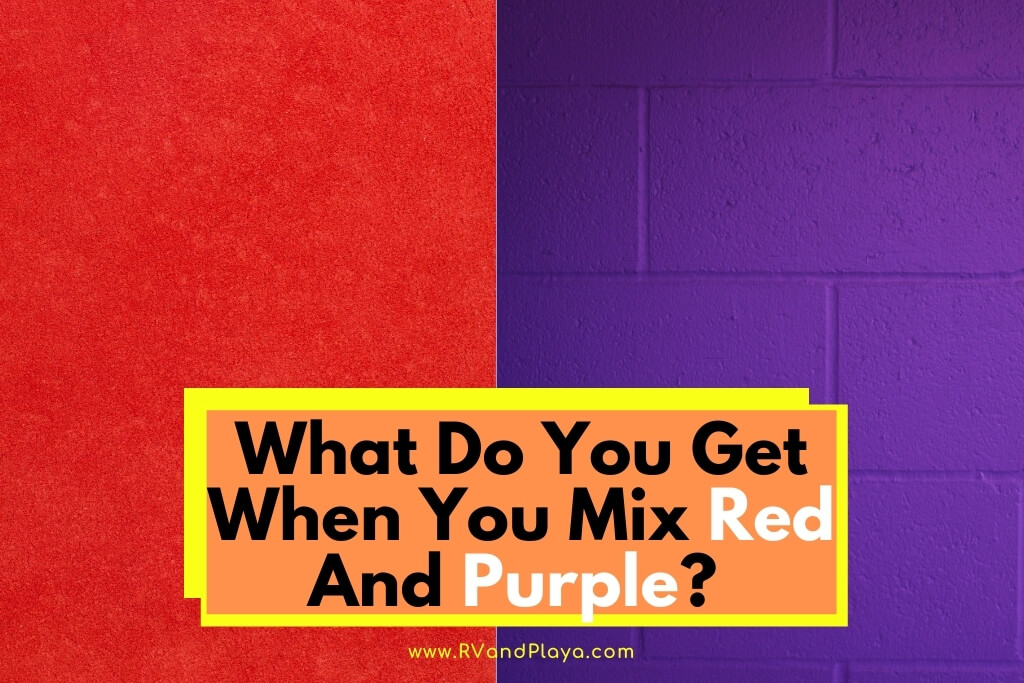What do you get when you mix red and purple together?
Many people wonder what happens when they mix red and purple together. If you mix red and purple together, you will end up with a reddish-purple or magenta color. Mixing colors is a fun way to create different shades. There are so many different colors on the color wheel, and by mixing certain ones, you can create more.
In order to get the color purple, you need to mix red and blue. Adding more red color to the purple will leave you with a reddish-purple color that is similar to magenta.
When you take a look at the color wheel, you’ll notice several shades of purple between the standard purple and the red. Mixing red with purple will give you the potential to create any of those colors.
Are you interested in learning more about mixing red with purple? Keep reading for all the information you need.
Table of Contents
What happens when you mix red and purple?
Red is already part of the makeup of purple. Purple is a secondary color, while red is a primary color. All the secondary colors were created by mixing two primary colors.
In the case of purple, red and blue were used. By adding more red to the purple, the results will be a purple shade with more red than blue to the mix.
There are many shades of every color. Mixing red and blue together won’t just create any purple color. You need to have a certain ratio of both. When you mix red with purple, you have the potential to make colors such as:
- Magenta
- Mulberry
- Plum
- Boysenberry
- Wine
- Grape ; more
Reddish purple colors are similar to what you would see if you poured a glass of merlot or spread some mixed berry jam.
There is more of a wine-colored tint than purples that have more blue to them, such as periwinkle and orchid.
Mixing Purple And Red Color | Color Mixing >> Check out the video below:
What happens when you mix primary and secondary colors together?
Mixing red and purple is a combination of primary and secondary colors. A rule of mixing colors is that two primary colors create secondary colors, but all three primary colors create brown.
This also means that mixing two secondary colors together will create brown because they feature mixes of primary colors.
This leaves the rule of mixing a primary color with a secondary color. The color you get will depend on which primary and secondary colors get mixed together.
If a secondary color gets mixed with a primary color that’s part of its makeup, then it will become a shade of the secondary color that’s close to the primary color.
Mixing red with purple will likely create a nice berry color while mixing blue with purple will create a violet shade.
Can you mix neutral colors with red and purple?
Mixing a neutral color with the red and purple mix is a great way to soften or darken the color you are making. Neutral colors consist of white, black, and tan.
They aren’t used to make other colors (except grey) but they can be used to make other colors lighter or darker.
This can be a very helpful technique for artists who are blending colors. It is also useful for fashion and choosing a color scheme for your home.
If you want a deeper or darker shade of reddish-purple, a touch of black can be added to get the desired color.
It’s important to only add a small amount of black at a time until you reach the shade you want. This is because black is very powerful, and if you add even a touch too much it could take over the entire color.
Using white to make a color lighter or softer is a lot simpler. Tan or gray can also be used to lighten up a color if you don’t want the results to be as bright.
White and red together create pink, and mixing that with purple can create fuchsia or magenta. These are very feminine colors that are popular in fashion and cosmetics.
What Colors Make Purple? The Ultimate Guide to Mixing Purple >> Check out the video below:
Using the color wheel to see what colors can be made
If you’re not sure what color you will get by mixing two colors, the color wheel can give you a good idea. The color wheel will show the three primary colors, 2 secondary colors, and all the shades in between.
It will also give you a better idea of the ratios you will need to mix up certain colors.
By examining this wheel, you’ll have a clear idea of what adding more red to purple will look like. It will also show you the other end of purple when more blue is added.
The color wheel not only groups colors together, but it also shows which colors are complementary colors. Complementary colors are across from each other on the color wheel.
They shouldn’t be mixed together unless you’re trying to create a brown shade. However, when these two colors are used in the same scheme, they will help each other pop.
Purple’s complementary color is yellow and red’s complementary color is green. The complementary color to the reddish-purple will be a greenish-yellow. This is similar to spring green or lime green, a popular shade in the summer.
While these paint colors shouldn’t be mixed together, these colors go together well in the world of fashion.
Should I mix red and purple?
Mixing your own paint colors is a great way to get creative and save money on art supplies. It can also help you achieve the exact shade of reddish-purple you have in mind.
This can be incredibly handy if you can´t find that shade at the local art store. However, getting the perfect ratio will take some practice
Don’t be discouraged if it takes a few tries to get the color just right. Even the best artists needed the practice to get their colors right.
You may also need to experiment by using some of the neutral colors to get the mix right.
If you are trying to lighten your color, try to avoid using yellow because that will turn your color to a brownish shade.
The good thing about mixing a primary color like red with its secondary color is that if you add too much red, you can reverse the mistake by adding a bit of blue.
Final thoughts
You can create almost any color by mixing other colors. Mixing the primary colors is how secondary colors are made.
When a primary color gets mixed with a secondary color, the secondary color will take on more of the shade from that primary color, In the case of mixing red with purple, you will get a result of a reddish-purple.
The blue shades in the purple will be less prominent than when the ratio was even. However, the same thing would happen if you were to add blue to purple. It would be a deeper bluish-purple and the red shades wouldn’t be as noticeable.
Taking a look at the color wheel will show you the key difference between reddish-purple and bluish-purple.
When you mix red with purple, you will get magenta and berry shades. These are excellent colors for fashion, cosmetics, and home decor.
Here are some of my favorite services, products, and Stores
There are affiliate links, so if you do decide to use any of them, I´ll earn a small commission. But in all honesty, these are the exact what I use and recommend to everyone, even my own family.
To see all my of most up-to-date recommendations, check out this resource that I made for you!
+ Products & Services
+ Convenience Stores
+ Save Thousands of Dollars
References
https://www.apartmenttherapy.com/red-and-purple-150652
Recent Posts
Have you ever wondered what color do you get when you mix red and pink? Mixing individual colors together may result in outcomes that you wouldn't expect, but it’s all based on the principles of...
What Do You Get When You Mix Red and Green? (Three Colors of Light)
Wondering what you will get when you mix red and green color? Life is full of beautiful colors. As humans, we can perceive such an array of colors to enjoy the entire rainbow and varying shades of...


